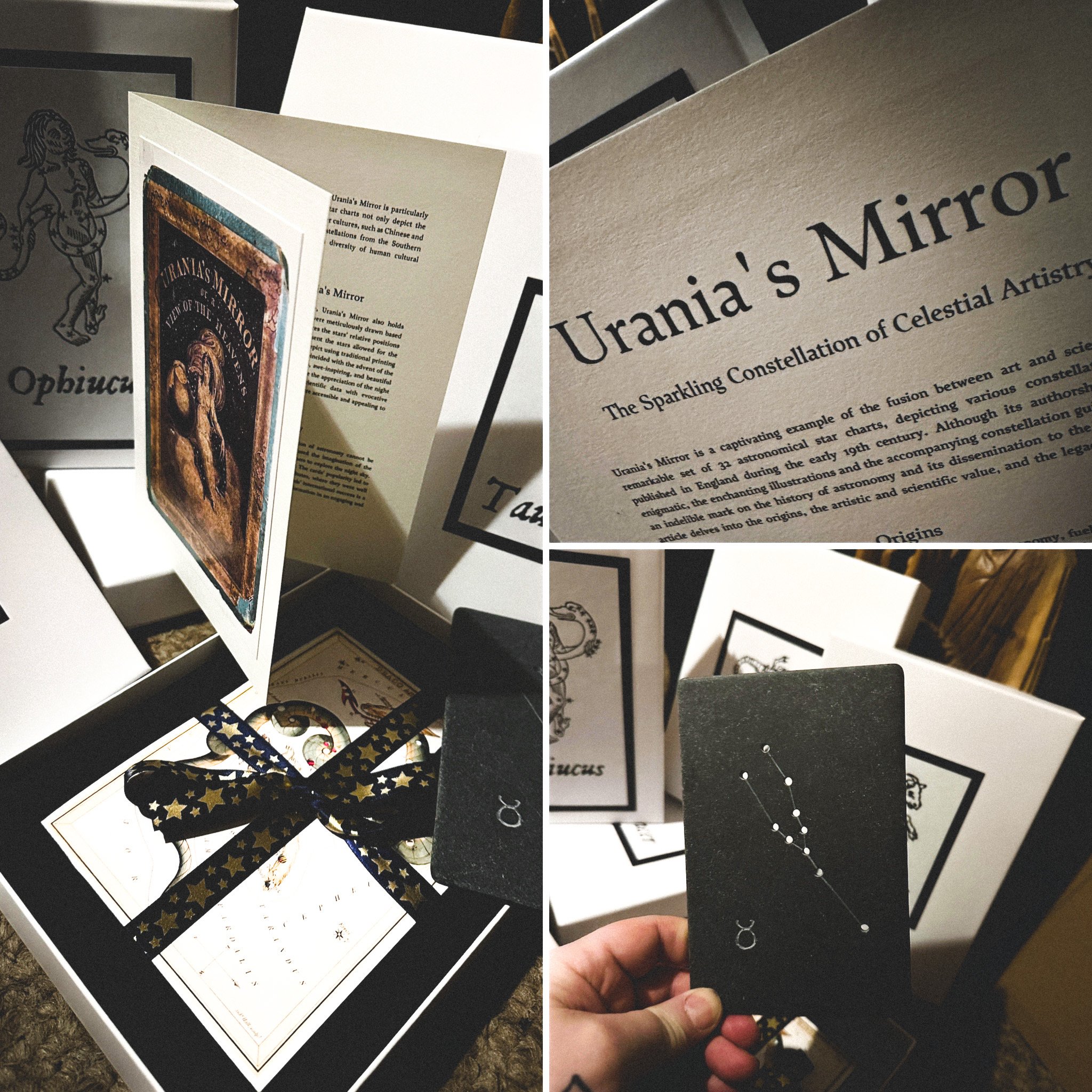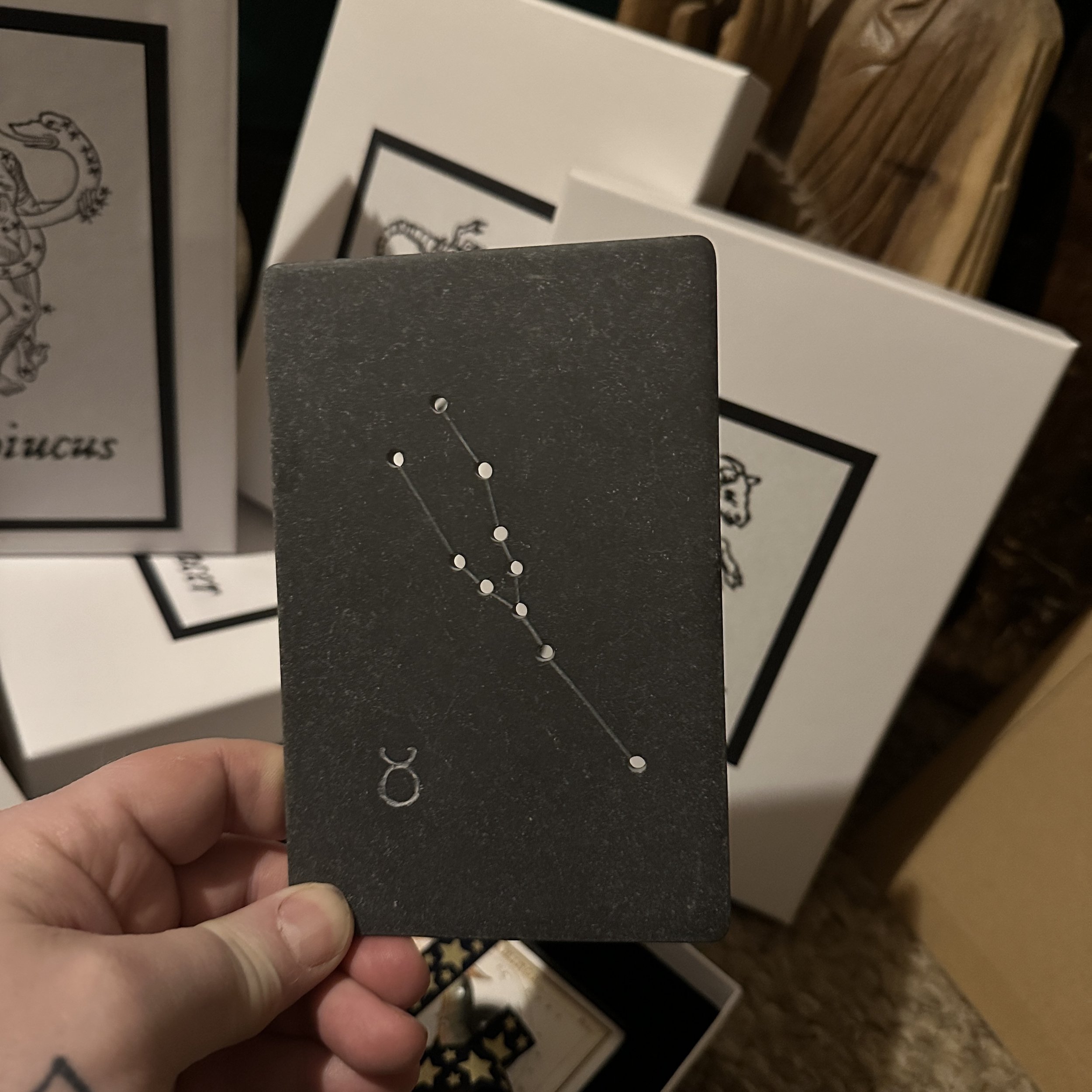 Image 1 of 4
Image 1 of 4

 Image 2 of 4
Image 2 of 4

 Image 3 of 4
Image 3 of 4

 Image 4 of 4
Image 4 of 4





Urania's Mirror Limited Edition Sets
INCLUDES
A set of 32 cards depicting the star signs of Urania’s Mirror. Each card is hand tooled with three apertures of stars. Details of why can be found in the history below.
A title card featuring a surviving image of the original box cover.
A 10cm x 15cm stone carving specific to the named set you order.
All housed in a book style deluxe box.
A PREMISE
A long time was spent deciding on the choice to either produce the cards as they have originally been restored and captured by Adam Cuerden, or to perform futher work on them in an attempt to have the cards appear' ‘new’. The decision was made to retain the work of Cuerden as this was keeping with the spirit of the cards as they have passed through time.
A HISTORY
Urania’s Mirror is a boxed set of 32 constellation cards first published by Samuel Leigh of the Strand, London, in November 1824. An advertisement and review in the The London Literary Gazette for 1824 November 27 describes them as ‘fitted up in an elegant box’ and selling for £1 8s black and white or £1 14s ‘beautifully coloured’. They were described as ‘An acceptable present’ so no doubt the publication was timed to catch the Christmas market. The engraver was Sidney Hall but authorship was coyly attributed to ‘a lady’.
Peter Hingley, former librarian of the Royal Astronomical Society in London, has established that the true author was almost certainly the Reverend Richard Rouse Bloxam (c.1765–1840) of Rugby (Journal of the British Astronomical Association, vol. 104, p. 238, 1994). There is, though, another possibility not mentioned by Hingley: Bloxham’s wife, Ann (1766–1835), was the sister of Sir Thomas Lawrence the portrait painter, so she might deserve at least a share of the credit as the anonymous ‘lady’.
One attractive feature of the cards is that they were perforated with small holes for each star, to give an impression of the constellation’s appearance when the cards were held up to the light. Doubtless many cards met an untimely end through being held too close to a candle flame. This feature will be hand replicated in each of these sets.
The cards were hand-coloured in water colours. While the colourists followed a general style, presumably laid down by the publishers, every set is slightly different. The cards came in a box with Urania herself, the muse of astronomy, depicted on the cover holding her traditional attributes of a celestial globe and a pair of dividers. Each set will come with an additional card featuring this artwork.
INCLUDES
A set of 32 cards depicting the star signs of Urania’s Mirror. Each card is hand tooled with three apertures of stars. Details of why can be found in the history below.
A title card featuring a surviving image of the original box cover.
A 10cm x 15cm stone carving specific to the named set you order.
All housed in a book style deluxe box.
A PREMISE
A long time was spent deciding on the choice to either produce the cards as they have originally been restored and captured by Adam Cuerden, or to perform futher work on them in an attempt to have the cards appear' ‘new’. The decision was made to retain the work of Cuerden as this was keeping with the spirit of the cards as they have passed through time.
A HISTORY
Urania’s Mirror is a boxed set of 32 constellation cards first published by Samuel Leigh of the Strand, London, in November 1824. An advertisement and review in the The London Literary Gazette for 1824 November 27 describes them as ‘fitted up in an elegant box’ and selling for £1 8s black and white or £1 14s ‘beautifully coloured’. They were described as ‘An acceptable present’ so no doubt the publication was timed to catch the Christmas market. The engraver was Sidney Hall but authorship was coyly attributed to ‘a lady’.
Peter Hingley, former librarian of the Royal Astronomical Society in London, has established that the true author was almost certainly the Reverend Richard Rouse Bloxam (c.1765–1840) of Rugby (Journal of the British Astronomical Association, vol. 104, p. 238, 1994). There is, though, another possibility not mentioned by Hingley: Bloxham’s wife, Ann (1766–1835), was the sister of Sir Thomas Lawrence the portrait painter, so she might deserve at least a share of the credit as the anonymous ‘lady’.
One attractive feature of the cards is that they were perforated with small holes for each star, to give an impression of the constellation’s appearance when the cards were held up to the light. Doubtless many cards met an untimely end through being held too close to a candle flame. This feature will be hand replicated in each of these sets.
The cards were hand-coloured in water colours. While the colourists followed a general style, presumably laid down by the publishers, every set is slightly different. The cards came in a box with Urania herself, the muse of astronomy, depicted on the cover holding her traditional attributes of a celestial globe and a pair of dividers. Each set will come with an additional card featuring this artwork.